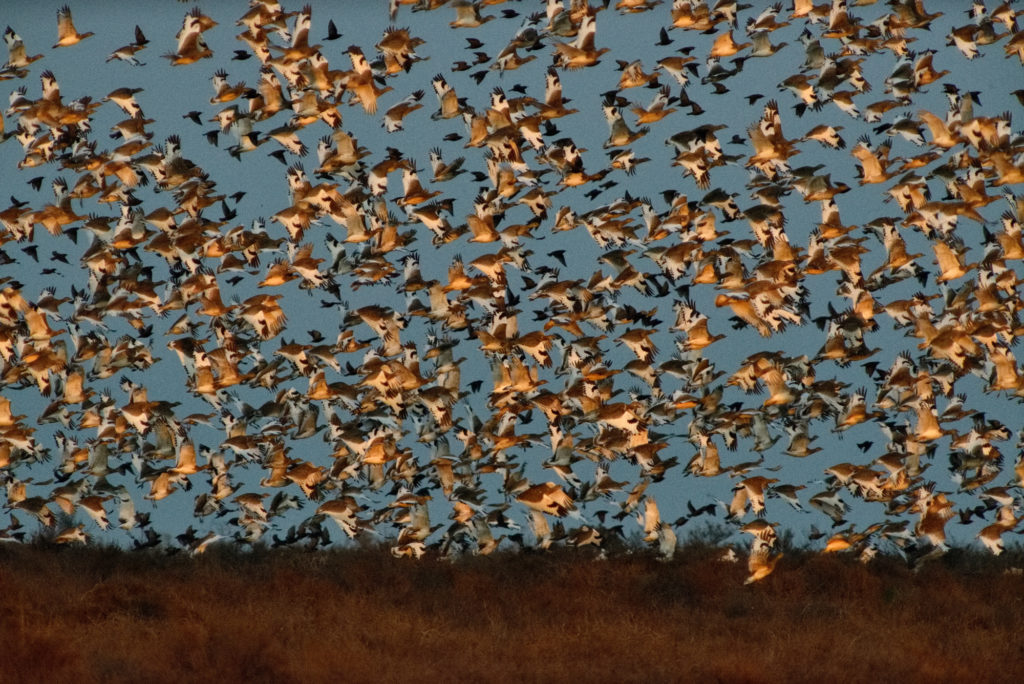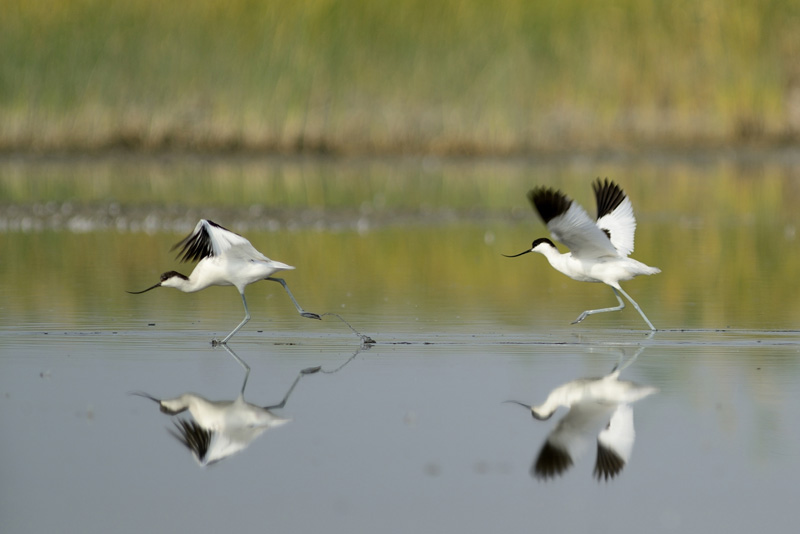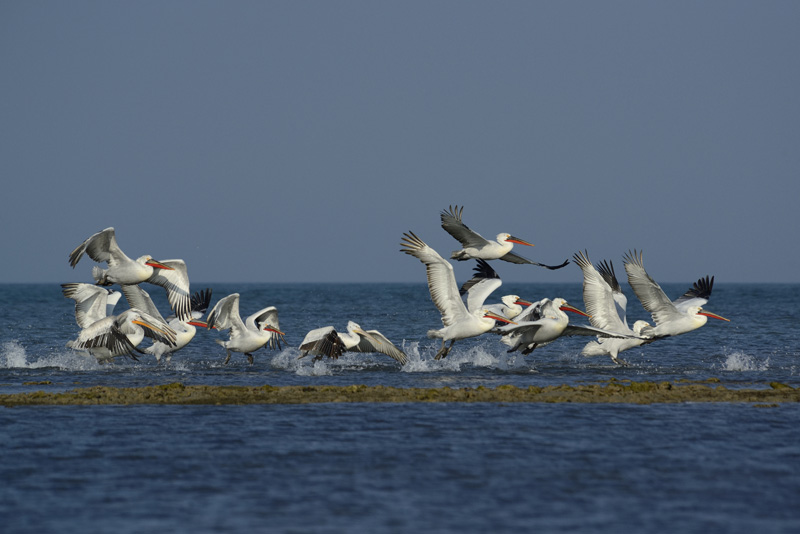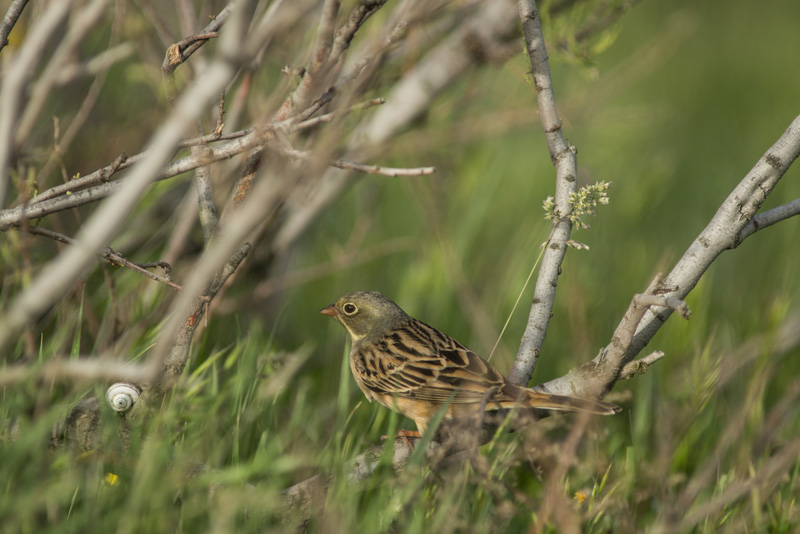Azerbaijan is uniquely placed as a crossroads for the annual migration of some 300 species of birds, as they travel vast distances across the globe. Conservation writer James Parry takes part in the annual Besh Barmag international Bird Camp, and discovers that the early bird really does get the first worm
Dawn on a grey day in late April, in the shadow of the distinctive rocky outcrop known as Besh Barmag, on the coast of Azerbaijan 90km north of Baku. They start to appear just as the early glimmers of light brighten the eastern sky. Only a few at first, flying in low and battling against the wind. Then more come into view, some in small groups and then in larger flocks. Migrating birds. Hundreds of them, all heading in the same direction, northwards, parallel to the western shore of the vast Caspian Sea. A steady and determined stream stretching as far as the eye can see.
From a ridge overlooking the flat coastal plain just inland from the beach, a group of ornithologists, muffled against the cold and armed with telescopes, binoculars and cameras, follow the birds as they file past. This team of Azeri, German and Swedish bird experts is gathered here for the second Besh Barmag international Bird Camp, organized by Nature Friends Azerbaijan, SOF Birdlife (based in Sweden) and the Azerbaijan Ornithological Society.
Birds of many different species are on the move. Some are easy to identify – such as beautiful pearl-grey male Pallid Harriers, with their languid flapping – while others prove much harder to tell apart. Small brown jobs whizz overhead, seemingly impossible to distinguish from one another. But the experts know how. “Red-throated Pipit!” calls out camp founder and coordinator Tomas Haraldsson, based on its brief flight note alone. Fellow birder Michael Heiss notes it down in the logbook for that day. Every bird that passes is counted and recorded.
It was Heiss, together with his friend Kai Gauger, who first discovered how important Besh Barmag is for migrating birds. A student at Greifswald University in Germany, Heiss came here initially for a month in the autumn of 2007 to carry out research on local birdlife. What he found was remarkable. “I was on the top of Besh Barmag, visiting as a tourist, when I noticed so many birds of different species passing by. I realised then that this might be a very important location for visible bird migration.”
Returning later for a longer period of study confirmed Heiss’s suspicions. “Migrating birds will always try to avoid having to cross dangerous obstacles, such as high mountains and large expanses of water,” he explains. “Besh Barmag sits at a bottleneck between the Caucasus range and the Caspian Sea, so the birds funnel through a corridor of land no more than two kilometres wide.” After several months of field observation, Heiss arrived at an incredible total of sightings. “The most I ever saw migrating in a single day was 157,000 Skylarks, plus an amazing 40,000 Little Bustards and tens of thousands of other birds,” he recalls. Overall, some 300 different species have been recorded at Besh Barmag, with an estimated 1 million birds passing through in spring and half as many again in autumn, when numbers are swollen by the year’s youngsters. The diversity is astounding, ranging from squadrons of majestic Dalmatian Pelicans and strings of elegant pied Avocets to smaller critters such as Ortolan Buntings, finding temporary shelter in the scrub and long grass.
Having such an avian goldmine on their doorstep has inspired local birders and conservationists to reach out to the wider public. “This place is ideal for introducing people to wildlife and to conservation issues generally,” says Elshan Nuriyev, chairman of Nature Friends Azerbaijan, which organises environmental education projects across the country and works with Tomas Haraldsson to organise annual bird camps at Besh Barmag. This April saw over thirty young naturalists gather for three days to watch the migrating birds and enjoy being outdoors in unspoilt landscapes. On one day over 100 science students from Baku University visited the camp and were treated to close-up views of birds captured by qualified bird ringer Pia Fetting from Germany. Birds such as Willow Warblers and Common Redstarts – on their way north to their breeding grounds in Russia after spending the winter in Africa – were caught in nets strung between bushes and then carefully extracted, examined and recorded before being released unharmed to continue their journey.
“By looking closely at the birds we can tell a lot about their condition and the physical demands of migration,” explains Fetting, who is back in Azerbaijan this autumn to carry out more research and monitoring. See her latest updates from Besh Barmag here.
The popularity of the camps with young people is evidence of a growing enthusiasm in the country for wildlife and conservation. “Environmental awareness is really picking up now,” explains Nature Friends volunteer Saida Valadzada, one of the camp coordinators. “Wildlife watching has become much more popular here and is opening up opportunities for eco-tourism.” A total of 115 bird species were seen during this spring’s camp, including 17 species of bird of prey ranging in size from the barn door-sized Black Vulture to the diminutive grasshopper-eating Lesser Kestrel. “To be honest, I wasn’t really that interested in birds until I came to Besh Barmag,” admits Sevinj Mammadova, one of this year’s participants. “But I love being here among nature, seeing the birds passing by on their journeys, and now I’m really hooked.”
It’s clear that Besh Barmag is a globally important hotspot for bird migration. “Most of the birds that pass through here breed further north and spend their winters far to the south,” explains Haraldsson. “They are part of an international network. Birds know no frontiers, and that’s why we are working to promote cooperation between birdwatchers of different nationalities too.”
Photography by Emil Khalilov
See a film about this spring’s Besh Barmag bird camp here.
And for more about the bird camp initiative, visit this link.







